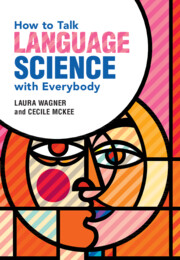Book contents
- How to Talk Language Science with Everybody
- How to Talk Language Science with Everybody
- Copyright page
- Contents
- Figures
- Preface
- Acknowledgments
- 1 Why Bother?
- 2 You Can Be the Expert
- 3 Cooperative Conversations
- 4 Conversational Goals
- 5 Know Your Audience
- 6 Creating Relevance by Generating Interest
- 7 Creating Relevance by Making Connections
- 8 Quality and Credibility
- 9 Quality vs Quantity
- 10 Learn to Listen
- 11 Information Structure
- 12 The Curse of Knowledge
- 13 Start with Examples
- 14 What’s New?
- 15 From Given to New
- 16 The Three-Legged Stool Approach
- 17 Working with a Range of Different Audiences
- 18 Where Can I Go?
- 19 Being a Good Partner
- 20 Finale
- Appendix Teaching with This Book
- References
- Index
16 - The Three-Legged Stool Approach
Published online by Cambridge University Press: 17 May 2023
- How to Talk Language Science with Everybody
- How to Talk Language Science with Everybody
- Copyright page
- Contents
- Figures
- Preface
- Acknowledgments
- 1 Why Bother?
- 2 You Can Be the Expert
- 3 Cooperative Conversations
- 4 Conversational Goals
- 5 Know Your Audience
- 6 Creating Relevance by Generating Interest
- 7 Creating Relevance by Making Connections
- 8 Quality and Credibility
- 9 Quality vs Quantity
- 10 Learn to Listen
- 11 Information Structure
- 12 The Curse of Knowledge
- 13 Start with Examples
- 14 What’s New?
- 15 From Given to New
- 16 The Three-Legged Stool Approach
- 17 Working with a Range of Different Audiences
- 18 Where Can I Go?
- 19 Being a Good Partner
- 20 Finale
- Appendix Teaching with This Book
- References
- Index
Summary
Chapter 16 opens by asking readers to identify the elements in their developing demonstrations that are in good shape and those that still need work. The chapter organizes such elements by analogy to a three-legged stool: One leg is a demonstration’s materials; another is a comprehensive plan; the third is the person doing the demonstration. Discussion of materials emphasizes practical considerations such as visual or manipulable items that are exciting, portability, backups, links to core points, and even duct tape. Discussion of plans emphasizes clarity on the demonstration’s goals, knowing how to use the materials, and having a stock of juicy questions; detailed plans make it easier to be flexible in the face of surprises. Discussion of the person emphasizes how people are crucial to cooperative conversations, how they make the materials more interesting and more entertaining, how their questions guide other people’s learning, and how they represent their fields. This chapter’s Closing Worksheet asks readers to write demonstration guidelines modeled in the Worked Example about a demonstration using dinosaurs to compare human language to other forms of communication.
Keywords
- Type
- Chapter
- Information
- How to Talk Language Science with Everybody , pp. 192 - 202Publisher: Cambridge University PressPrint publication year: 2023



